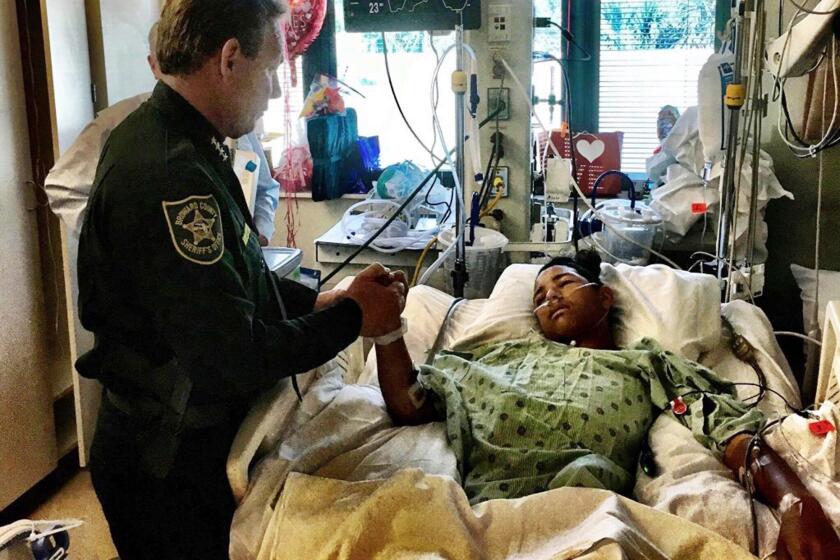U.S. Delays Pullout in Iraq
Postponing troops’ return to their families for the second time in two months, the Pentagon announced Monday that more than 10,000 soldiers of the 3rd Infantry Division would not, as they had been told, be coming home by the end of September.
The announcement came as India said it would not send a promised division that would have added 17,000 troops to the forces on the ground, although the Pentagon said there was no connection between the extended deployment and New Delhi’s decision.
For the record:
12:00 a.m. July 26, 2003 For The Record
Los Angeles Times Saturday July 26, 2003 Home Edition Main News Part A Page 2 National Desk 1 inches; 69 words Type of Material: Correction
Indian troops -- A July 15 article in Section A incorrectly said that the Indian government had promised to send a contingent of peacekeeping troops to Iraq. New Delhi turned down a U.S. request for such troops on July 14 but had made no promise that it would provide them. The story also gave the wrong name for the Indian foreign minister. He is Yashwant Sinha, not Jaswant Singh.
Two-thirds of the division will remain in Iraq “indefinitely,” said Richard Olson, a spokesman for the division at Ft. Stewart, Ga., its headquarters.
The division, which spearheaded the attack on Baghdad, had expected to receive orders in early June to return to the United States but instead was ordered to tamp down Iraqi resistance in the Sunni Muslim city of Fallouja.
On July 7, commanders told the soldiers of two of the high-profile division’s three combat brigades that they could expect to be withdrawn from the war zone beginning next month.
And last Thursday, Gen. Tommy Franks, who retired last week as commander of U.S. forces in Iraq, went even further, telling the House Armed Services Committee that the soldiers would be “out of Iraq by September.”
But continuing attacks on U.S. forces by Iraqi insurgents and the reluctance of other countries to commit troops are pressuring the Pentagon to maintain, if not bolster, the American military presence in the nation.
The effort to persuade other countries to supplement U.S. forces suffered a setback Monday with India’s announcement. Pakistan and Portugal -- two other countries the Pentagon had been counting on to send substantial numbers of troops -- have also balked.
U.S. officials had asked New Delhi for a full division -- about 17,000 soldiers -- which would have made India the third-largest contributor of troops, after the United States and Britain.
After mulling Washington’s requests for more than two months, officials in New Delhi said they had concluded that they could not take the politically unpopular move without the cover a United Nations mandate would provide.
Instead, Foreign Minister Jaswant Singh told reporters in New Delhi that the government would help rebuild Iraqi schools and medical and communications infrastructure, beginning with a hospital.
Relations Unharmed
“We would have hoped that they would have made a different decision,” State Department spokesman Richard Boucher said. But India “remains an important strategic partner for the United States,” he said, adding that the move would not harm relations between Washington and New Delhi.
Pentagon officials have declined to provide details on how many troops specific countries are providing for the Iraq occupation, but Defense Secretary Donald H. Rumsfeld said Sunday on ABC’s “This Week” that 19 countries were now taking part, 19 had agreed to assist in the future and the United States was talking to 11.
He said the contributors represented “a very large international coalition.”
Still, most of the countries that are taking part are contributing small numbers of troops, ranging in many cases from only a few dozen to a few hundred.
Indeed, although the United States has until now opposed the idea of giving the U.N. a powerful role in Iraq, fearing that doing so could complicate rebuilding efforts, one senior U.S. official noted that several countries have said they required the imprimatur of U.N. participation before they would contribute troops.
The official speculated that there could soon be new deliberations at the U.N. about steps to strengthen its role.
“I don’t know how this will evolve overall, in terms of the United Nations, and whether the U.N. wants to consider a different, stronger mandate,” the official said. “I wouldn’t say there’s any momentum yet. We’ll just have to see how it evolves.”
As of late last week, the 3rd Infantry Division had 15,900 soldiers in Iraq, part of a total U.S. force in the country of 148,000. Pentagon officials said last week that 142,000 military personnel who had been deployed to fight the war had returned to their home bases, although most of those serve in the Air Force and Navy, leaving the burden in Iraq to ground forces. The current ground force figure is down from its peak of 151,000.
As recently as May, the Bush administration had said it hoped to shrink the American military presence in Iraq to two divisions, by about 30,000 to 40,000 troops, by autumn, with a third division from another country also present, Pentagon officials said.
The announcement about the 3rd Division dashes the hopes for reunion by thousands of Army families, who had been separated up to 10 months from their loved ones.
The division has suffered 36 deaths in the war -- more than any other unit -- and some of its troops have been in the region since September.
“All I know is there’s a lot of disappointed families here, that’s for sure,” said Olson, the division spokesman. “There was great hope, and people had really inscribed that September date in their minds and hearts. And the announcement today retracts the hope.”
Lawrence Di Rita, a senior Rumsfeld aide and the acting Pentagon spokesman, minimized the significance of the delay in pulling out 3rd Infantry Division troops, saying plans are to bring the soldiers home “in the fall.”
“The details of the redeployment are complex and subject to discussion and change, but the expectation remains that the rest of the division will be back to the U.S. by sometime in the fall,” Di Rita said.
He said the delay in redeploying the troops was unrelated to the security situation in Iraq.
“That’s absolutely not what’s under discussion,” Di Rita said. “What’s under discussion is how do you prepare for an orderly redeployment of these forces? There has been no change in the overall plans for the 3rd Division.”
Two-Thirds Affected
The announcement affects about two-thirds of the division’s soldiers. They are the 4,500 troops of the 1st Brigade Combat Team, another 4,500 of the 2nd Brigade Combat Team, about 800 of the 3rd Squadron 7th Cavalry, about 500 from the division’s headquarters and headquarters support commands and about 100 from the headquarters engineer brigade.
Those soldiers, a terse announcement from the division’s headquarters said, “will remain in Iraq to maintain the current force level.”
A third combat brigade and a number of the division’s smaller companies and battalions, which had already begun leaving Iraq, will return home in August.
Last week Franks and Rumsfeld parried persistent questions from lawmakers on the future of the division’s soldiers -- many of whom have recently complained openly about their long deployments -- by pointing to the impending return of the troops.
On Wednesday, Rumsfeld told the Senate Armed Services Committee that “the rotation out of Iraq is already starting.... The 2nd Brigade is -- the plan is they would return in August ... and the 1st Brigade of the 3rd Infantry Division is scheduled to return in September,” he said.
Rumsfeld added that it was important to develop a rotation plan so “that we treat these young men and young women in a way that’s respectful of their lives and their circumstances and the wonderful job they did.”
The next day Franks told the House Armed Services Committee that the withdrawal was certain.
“That great division, sir, one of the brigades -- there are three brigades in that division, and one of them is beginning its redeployment now ... the second will begin its redeployment next month, and the third and final brigade of the 3rd Infantry will be out of Iraq by September.”
The comments by Rumsfeld and Franks were based on a July 7 announcement from the division’s commander in Iraq, Maj. Gen. Buford Blount, that a timeline had been set for the return of the soldiers.
But on Monday, Blount told soldiers the decision to send them home had been reversed.
“Generally speaking, two-thirds of the division will remain there indefinitely. It will be announced when they’re released from their commitment,” Olson said.
On Capitol Hill, lawmakers said the news was sure to hurt morale in the Army, which has been shouldering the burden in Iraq since President Bush announced an end to major combat operations there on May 1. They also said the news demonstrates that the war on terrorism has overburdened the Army.
“The soldiers were led to believe they would not be long. In fact, they were told they would be going home in September,” said Rep. Ike Skelton (D-Mo.), the ranking Democrat on the House Armed Services Committee. “No. 1, that will not help morale at all. No. 2 ... we need a larger Army. We need more soldiers so we can rotate more readily and more easily.”
More to Read
Sign up for Essential California
The most important California stories and recommendations in your inbox every morning.
You may occasionally receive promotional content from the Los Angeles Times.









